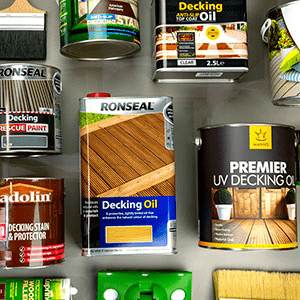Garden Furniture Finish FAQ's
Advise needed on how to clean garden furniture?
If left unprotected and not maintained, wooden garden furniture can soon start to look tired and neglected. Common issues include green or black discolouration as a result of mould, algae and other biological growth. If left untreated for a number of years, the wood will eventually turn grey or silver. The good news is that these issues can usually be resolved.
For mould, algae and other biological growth we recommend using a garden furniture cleaner. Heavily soiled furniture may require 2 treatments.
To help restore the colour of wood that has turned grey or silver, we recommend using Osmo Wood Reviver Gel (6609) or Cuprinol Garden Furniture Restorer. Wood that has been grey / silver for a number of years may require 2 treatments of the selected wood restorer.
To protect cleaned and restored garden furniture prior to oiling, we recommend using an exterior wood preservative, suitable for garden furniture.
To re-nourish, protect and restore the appearance of wooden garden furniture, we recommend using a garden furniture oil.
Need advise on how to protect garden furniture?
The advice on how to protect wooden garden furniture can depend on if the furniture is new or old, untreated or pre-treated, and what type of wood it is made from.
Generally speaking, most wooden garden furniture is either tanalised or oiled. New and old softwood and hardwood garden furniture is usually maintained by periodically applying a garden furniture oil. If the furniture has not been treated for a number of years, has green or black staining, or has turned grey or silver, it will need several treatments to restore its appearance. See the question on 'how to clean garden furniture' for a step by step guide and the products we recommend.
Read our blog posts on how Your Wooden Garden Furniture Can Outlive You and How to Put Spring Back Into Garden Furniture for further tips and advice.
How can I restore Teak garden furniture?
Teak garden furniture is highly resistant to weathering and usually just needs cleaning with a garden furniture cleaner and a fresh treatment of Teak Oil to restore the appearance of tired looking wood.
Teak garden furniture that has turned grey or silver should be treated with a wood restorer such as Cuprinol Garden Furniture Restorer or Osmo Wood Reviver Power Gel prior to applying garden furniture oil. This will help to restore the original colour of the wood prior to oiling.
Can I varnish my garden furniture?
There are a number of clear and coloured exterior varnishes suitable for garden furniture. An alternative to an exterior varnish is a clear or coloured exterior wood oil. These are easier to maintain and less problematic in the long term.
I have a worktop outside that I use to serve hot food from. It has already been painted yellow and I'm looking to protect it without changing the colour too much. What would you recommend?
Polyvine Decorators Varnish is an exterior-grade clear, water-based acrylic varnish for use on wood, paintwork, wallpaper, fabric, plaster and much more. It contains UV filters to protect coloured surfaces from fading and biocides that protect against algae, mildew and fungal attack.
Oils would not be suitable as they need to penetrate into the wood and cannot if the paint has formed a coating on the wood. They are also more likely to discolour the finish due to the nature of the ingredients they are made from.
We can never guarantee one manufacturers product over another and a test area is essential to test product suitability and final finish.
How do I remove Creocote from my wooden bench?
Unfortunately this will be quite difficult to remove as the Creocote dries by absorption into the wood, rather than by forming a film, so may transfer for some time.
If the application was recent, it may be possible to remove the worst by wiping down thoroughly with white spirit and plenty of rags. However, the colour will not be removed and there will still be some risk of transference.
However, once the bench has thoroughly dried then it should be possible to seal in the remaining Creocote with a solvent-based product such as Barrettine Premier Wood Preserver in Clear or Coloured. Barrettine Decking Oil in Clear would also be suitable, but the coloured versions of this would not be.
I'm looking to stain my garden furniture grey, just like some Argos furniture I have seen. I have ordered a sample of the Osmo Oil in light grey but am wondering if there is anything else you recommend? I don't want it to look painted just stained.
Having looked at the pictures of the Argos furniture you are trying to match, I would say that it is likely that the furniture already has a finish of some sort on it and it will be difficult to recommend anything without knowing what that treatment is. It may be worth contacting Argos to see if they can find out from the manufacturer what the grey finish is. Sanding your garden furniture back to bare wood would open up you options for achieving the grey, stained look.
On bare wood, consider products such as Holzol Weather Oil and Osmo Natural Oil Woodstain. Both are penetrating oils that gives a translucent finish similar to that of the furniture you are trying to match.
Or if the current finish is an oil then you may be able to apply fresh coats in around a years time when the current one has worn slightly, however the current colour of the wood will also impact on the type of grey you will be able to achieve and this is why test areas are always important.
I hope this helps but if you have any further questions or need further assistance with your project, please do not hesitate in contacting us.
I have bought untreated teak garden furniture that is quite light interestingly. I have used Danish oil from Rustins, natural tint allegedly, but it has darkened the colour of the woord quite a bit. I am also a newbie to dyi and have created quite an uneven finish. I'd like to start over. What are your recommendations in terms of the most invisible oil? Also, would you sand the furniture before starting over to even things out?
Application of almost any wood oil will darken the wood to some degree and enhance the natural colour tones and character of the timber. The type, age and condition of the wood will all have an impact on the final, oiled colour. Teak, is generally a darker and slightly more red toned wood and any applied oil will highlight this richness.
It will be difficult to maintain the lighter, natural colour with a penetrating product. On a tropical hard wood such as Teak, you could consider Osmo UV Protection Oil Extra Natural (429), however I would strongly recommend a test area first because of the type of wood you are applying to. This product contains a small amount of white pigment that counteracts the darkening effect of the oil. Whilst it works very well on lighter coloured timbers, is can leave a slightly milky hue on darker woods. Some people like this and other don't, so trying the sample sachet is a good place to start.
To use this oil you would need to sand the furniture back to bare wood first, to remove the current finish.
The unevenness in the first finish could be just a result of the wood and the absorbsion of the oil. Wood is not uniform as it grows so some areas can be more dense than others. This means that the oils can be absorbed unevenly meaning that it may sink further into some areas than others. This can usually be rectified by applying another thin coat but it's important to not over apply the oil and to remove any excess from the surface of the wood with a clean, lint-free cloth.
This is a simple flat seat for a garden swing which I have made from a handsome piece of walnut. Which is the best choice of oil to protect and enhance the lovely wood.
Walnut is a fairly dense wood and for this reason we would recommend trying a sample tin of Osmo Decking Oil. The reason for this is that it is a thin, refined oil that will penetrate in to the wood grain better than some alternative wood oils. Oil is better for exterior projects as it will not peel and flake over time and is far easier to repair and maintain. Leaving the wood looking and feeling very natural. Only two very thin coats are required. A little oil goes a long way and by the sounds of it, a sample tin should be sufficient to complete this project.
Always do a test area to assess product suitability and final finish before starting the project.
I have just bought a garden bridge, made from pressure-treated Scandinavian redwood. I have given it an initial treatment of Cuprinol Wood Preserver (clear), bought from yourselves. I would prefer to stain it a green colour now - what is the best one to use? It has two handrails, so would like them to stay smooth, but not too slippery for the footbridge. Thanks for any advice.
There are a couple of options you are able to consider. The first is sticking with Cuprinol and looking at the Cuprinol Anti-Slip Decking Stain this is a surface sealer that will provide an anti slip finish for the bridge.
Alternatively, Holzol Decking Oil has a green within its range. This is a penetrating oil that gives a more natural look and feel to the wood, whilst still offering a durable finish. Oils are easier to maintain and repair than a surface sealers such as the Cuprinol Decking Stain as they will not crack, flake or peel.
Can I paint wooden garden furniture?
If the furniture is new, untreated or tanalised wood then the answer is likely to be yes. We recommend using a dedicated garden paint such as Cuprinol Garden Shades or Ronseal Garden Paint and doing a small test area, on the underside of the table or chair first to test colour and product suitability.
Old garden furniture that has been left untreated for a number of years and where the wood has turned grey or silver over time can usually be lightly sanded then painted. Water-based garden paints can be problematic on new garden furniture made from dense, exotic hardwoods such as Teak, or furniture that has an oiled finish.
Older garden furniture that has been affected by mould, algae and other biological matter must be thoroughly cleaned prior to painting with a mould and mildew cleaner.
Find the right garden furniture treatment for your furniture
- Garden Furniture Cleaner
- Wood Preservers Suitable For Garden Furniture
- Garden Furniture Oils
- Garden Furniture Stains
- Garden Furniture Paints
Garden furniture related blog posts
Disclaimer: Whilst every attempt has been made to provide product information that is as accurate as possible, it's important to clarify that trees and the wood that they produce can be affected by many factors. For example, the same species of tree grown in the same wood, even in close proximity, will be affected by age along with the amount of sunlight and water they receive. Other naturally occurring biological and environmental factors will also influence the density and grain of the wood as well as the moisture and oil content of the timber. No two trees are the same, meaning each piece of wood has the potential to look and react differently to the same wood finish. For example, product adhesion, colour variations, absorption rates and sheen levels. It is for this reason that we always strongly recommend carrying out test areas before starting any project


